Spatial Sustainable Development Assessment Using Fusing Multisource Data from the Perspective of Production-Living-Ecological Space Division: A Case of Greater Bay Area, China
Abstract
:1. Introduction
2. Materials and Methods
2.1. Production-Living-Ecological Space Division Method from the Perspective of Multi-Functional Land
2.2. Modified Land Use Efficiency Indicators
2.3. Analytic Hierarchy Process for Evaluation of Space Sustainable Development
- Establishing a hierarchical structure model: In this study, the entire research decision-making process was divided into three levels from top to bottom according to the AHP: a target layer, a criterion layer, and a program layer. The target layer includes the degree of sustainable development of the space. The criterion layer includes the degree of sustainable development of the ecological space, production space, and living space. The program layer includes the two land use efficiency indicators and the sub-indices corresponding to the production-living-ecological space. Together they form a set of assessment hierarchy models of spatial sustainability (Figure 3).
- Constructing a judgment matrix: As is shown in Equation (5), according to the relative importance of the criterion layer indicators and referring to Table 2 for the meaning of the judgment matrix scale, a judgment matrix was constructed. In matrix A, is the importance of compared to .
- Calculating the weight and the largest eigenvalue: The arithmetic mean method was used to calculate the weight of each indicator. The calculated weight of each indicator was taken as the eigenvector , which was multiplied by the judgment matrix A to obtain . The maximum eigenvalue calculation formula was used to calculate the maximum eigenvalue . The formula for calculating the maximum eigenvalue is as follows:
- Consistency test: To test whether the weights assigned to each indicator value in the constructed judgment matrix are reasonable, a consistency test is required. The consistency verification formula iswhere CI is the consistency indicator, CR is the consistency ratio, and RI is the random consistency indicator. The consistency test is passed when CR < 0.1. Among them, the formula for calculating CI isCR = CI/RI,
2.4. Study Area and Data
3. Results
3.1. Results of the Production-Living-Ecological Space Division in the GBA Based on the LUCC
3.2. Urban Agglomeration Scale: The Sustainable Development of Space Is Improving
3.3. Prefecture-Level City Scale: There Are Differences in Spatial Sustainable Development
4. Discussion
4.1. Value and Contribution of LUCC Remote Sensing Data
4.1.1. Advantages of LUCC Remote Sensing Data Products
4.1.2. Contribution of LUCC Data in This Study
4.2. Importance of Introducing the Economic Dimension and Conducting Multiscale Analysis
- At the urban agglomeration scale in the GBA: based on the principle of people-oriented and high-quality spatial development, we should actively promote the synergistic optimization of the relationship between the production-life-ecological spaces; enriching the multi-functionality of the land use types’ attributes. This should include improving the efficiency of land resource utilization, promoting the optimization of the urban layout, and formulating phased development goals, maintaining and utilizing the inertia of the trend of improving the sustainability level of the land space in the past 20 years.
- At the prefecture-level city scale in the GBA: the main goals should be identifying prefecture-level cities with declining levels of sustainable development, comparing the extent of the decline, and implementing targeted optimization plans to varying degrees. In addition, before implementing specific optimization plans, the different resources, environmental carrying capacity, and development suitability of these prefecture-level cities should be considered. Differentiated spatial development policies should be formulated according to the development mode and intensity of the space to promote overall improvement of the three types of spaces in the GBA.
- Regarding the living spaces in the GBA: (1) The expansion of built-up areas should be controlled. (2) Infrastructure construction should be strengthened. (3) The three-dimensional transportation development mode should be improved. (4) Transportation accessibility should be improved. (5) The service scope of public facilities should be expanded. Rationally distributing dynamic living areas such as parks and squares should be appropriately increased to facilitate people’s leisure and entertainment. Regarding the production spaces: (1) Local natural, policy, and economic conditions should be taken into consideration. characteristic and advantageous industries should be developed according to the local conditions. (2) The optimization and coordination of the three major industrial structures in the GBA should be promoted. (3) Investments in science and technology should be increased to improve production efficiency. (4) Agglomeration development should be implemented to achieve complementary advantages, resource sharing, and the effect of 1 + 1 > 2. Regarding the ecological spaces: (1) Ecological barriers should be consolidated. (2) Soil and water conservation should be strengthened. (3) The original ecological spaces such as mountains, rivers, forests, fields, lakes, and grasslands should be protected. (4) Tree planting and afforestation should be increased. (5) Modern ecological construction methods such as green buildings and roof gardens should be popularized. (6) The incorporation of ecological space into living space and production space should be promoted. (7) The reasonable restoration and planning of new ecological spaces should be implemented.
4.3. Uncertainties and Future Work
4.3.1. Demarcation of Production-Living-Ecological Spaces Based on Multi-Functionality of Land Use
4.3.2. AHP Weight Assignment
4.3.3. Prospects for the Use of This Method
5. Conclusions
Author Contributions
Funding
Data Availability Statement
Conflicts of Interest
Abbreviations
| GBA | The Guangdong-Hong Kong-Macao Greater Bay Area |
| SDV | Sustainable development index value |
| SDL | Sustainable development level |
| LCR | Land consumption rate |
| PGR | population growth rate |
| EGR | economic growth rate |
| LCRPGR (LP) | The ratio of the LCR to the PGR |
| LCREGR (LE) | The ratio of the LCR to the EGR |
| AHP | Analytic hierarchy process |
References
- Transforming Our World: The 2030 Agenda for Sustainable Development; United Nations: New York, NY, USA, 2015.
- Grimm, N.B.; Faeth, S.H.; Golubiewski, N.E.; Redman, C.L.; Wu, J.; Bai, X.; Briggs, J.M. Global change and the ecology of cities. Science 2008, 319, 756–760. [Google Scholar] [CrossRef] [PubMed] [Green Version]
- United Nations. World Urbanization Prospects: The 2014 Revision, Highlights; Department of Economic and Social Affairs, Population Division, United Nations: New York, NY, USA, 2014. [Google Scholar]
- Rieniets, T. Shrinking cities: Causes and effects of urban population losses in the twentieth century. Nat. Cult. 2009, 4, 231–254. [Google Scholar] [CrossRef]
- Beyer, E.; Hagemann, A.; Rieniets, T.; Oswalt, P. Atlas of Shrinking Cities; Hatje Cantz: Ostfildern-Ruit, Germany, 2006. [Google Scholar]
- Sun, L.; Chen, J.; Li, Q.; Huang, D. Dramatic uneven urbanization of large cities throughout the world in recent decades. Nat. Commun. 2020, 11, 5366. [Google Scholar] [CrossRef] [PubMed]
- Bain, P.G.; Kroonenberg, P.M.; Johansson, L.O.; Milfont, T.L.; Crimston, C.R.; Kurz, T.; Bushina, E.; Calligaro, C.; Demarque, C.; Guan, Y.; et al. Public views of the sustainable development goals across countries. Nat. Sustain. 2019, 2, 819–825. [Google Scholar] [CrossRef] [Green Version]
- Elmqvist, T.; Andersson, E.; Frantzeskaki, N.; McPhearson, T.; Olsson, P.; Gaffney, O.; Takeuchi, K.; Folke, C. Sustainability and resilience for transformation in the urban century. Nat. Sustain. 2019, 2, 267–273. [Google Scholar] [CrossRef]
- Caprotti, F.; Cowley, R.; Datta, A.; Broto, V.C.; Gao, E.; Georgeson, L.; Herrick, C.; Odendaal, N.; Joss, S. The New Urban Agenda: Key opportunities and challenges for policy and practice. Urban Res. Pract. 2017, 10, 367–378. [Google Scholar] [CrossRef] [Green Version]
- UN-Habitat. SDG Indicator 11.3.1 Training Module: Land Use Efficiency; UN-Habitat: London, UK; Sterling, VA, USA, 2018. [Google Scholar]
- Mudau, N.; Mwaniki, D.; Tsoeleng, L.; Mashalane, M.; Beguy, D.; Ndugwa, R. Assessment of SDG indicator 11.3. 1 and urban growth trends of major and small cities in South Africa. Sustainability 2020, 12, 7063. [Google Scholar]
- Koroso, N.H.; Lengoiboni, M.; Zevenbergen, J.A. Urbanization and urban land use efficiency: Evidence from regional and Addis Ababa satellite cities, Ethiopia. Habitat Int. 2021, 117, 102437. [Google Scholar] [CrossRef]
- Nicolau, R.; David, J.; Caetano, M.; Pereira, J.M. Ratio of land consumption rate to population growth rate—Analysis of different formulations applied to mainland Portugal. ISPRS Int. J. Geo-Inf. 2018, 8, 10. [Google Scholar] [CrossRef] [Green Version]
- Wang, Y.; Huang, C.; Feng, Y.; Zhao, M.; Gu, J. Using earth observation for monitoring SDG 11.3. 1-ratio of land consumption rate to population growth rate in Mainland China. Remote Sens. 2020, 12, 357. [Google Scholar] [CrossRef] [Green Version]
- UK Office for National Statistics. Using Innovative Methods to Report against the Sustainable Development Goals. 2018. Available online: https://www.ons.gov.uk/economy/environmentalaccounts/articles/usinginnovativemethodstoreportagainstthesustainabledevelopmentgoals/2018-10-22 (accessed on 1 December 2018).
- Commissariat General au Developpement Durable. Indicateurs Nationaux de la Transition Ecologique Vers Undeveloppement Durable (2015–2020); Commissariat General au Developpement Durable: Paris, France, 2016; Available online: http://www.statistiques.developpement-durable.gouv.fr/indi-cateurs-indices/f/.2491/0/artificialisation-sols-1.html (accessed on 1 December 2018).
- Jiang, H.; Sun, Z.; Guo, H.; Weng, Q.; Du, W.; Xing, Q.; Cai, G. An assessment of urbanization sustainability in China between 1990 and 2015 using land use efficiency indicators. npj Urban Sustain. 2021, 1, 34. [Google Scholar] [CrossRef]
- Estoque, R.C.; Ooba, M.; Togawa, T.; Hijioka, Y.; Murayama, Y. Monitoring global land-use efficiency in the context of the UN 2030 Agenda for Sustainable Development. Habitat Int. 2021, 115, 102403. [Google Scholar] [CrossRef]
- Zhu, J.; Hou, Z.; Li, X.; Xu, J. The Effect and Mechanism of Urbanization on Rural Revitalization in China. Econ. Geogr. 2022, 42, 200–209. [Google Scholar]
- Liu, Y.; Li, Y. Revitalize the world’s countryside. Nature 2017, 548, 275–277. [Google Scholar] [CrossRef] [PubMed]
- Li, G.; Fang, C. Quantitative function identification and analysis of urban ecological-production-living spaces. Acta Geogr. Sin. 2016, 71, 49–65. [Google Scholar]
- Liu, J.; Liu, Y.; Li, Y. Classification evaluation and spatial-temporal analysis of “production-living-ecological” spaces in China. Acta Geogr. Sin. 2017, 7, 1290–1304. [Google Scholar]
- Huang, J.; Lin, H.; Qi, X. A literature review on optimization of spatial development pattern based on ecological-production-living space. Prog. Geogr. 2017, 36, 378–391. [Google Scholar]
- Wheatley, M.; Johnson, C. Factors limiting our understanding of ecological scale. Ecol. Complex. 2009, 6, 150–159. [Google Scholar] [CrossRef]
- Turner, M.G.; O’Neill, R.V.; Gardner, R.H.; Milne, B.T. Effects of changing spatial scale on the analysis of landscape pattern. Landsc. Ecol. 1989, 3, 153–162. [Google Scholar] [CrossRef]
- Peng, J.; Ma, J.; Du, Y.; Zhang, L.; Hu, X. Ecological suitability evaluation for mountainous area development based on conceptual model of landscape structure, function, and dynamics. Ecol. Indic. 2016, 61, 500–511. [Google Scholar] [CrossRef]
- Zeng, W. Study on Urban Residents’ Living Space During the Transition Period; Nanjing Normal University: Nanjing, China, 2015. [Google Scholar]
- Cui, J.; Gu, J.; Sun, J.; Luo, J. The Spatial Pattern and Evolution Characteristics of the Production, Living and Ecological Space in Hubei Provence. China Land Sci. 2018, 32, 67–73. [Google Scholar]
- Song, X.; Wu, Z.; Ouyang, Z. Changes of cultivated land function in China since 1949. Acta Geogr. Sin. 2014, 69, 435–447. [Google Scholar]
- Liao, G.; He, P.; Gao, X.; Deng, L.; Zhang, H.; Feng, N.; Zhou, W.; Deng, O. The production–living–ecological land classification system and its characteristics in the hilly area of Sichuan province, southwest China based on identification of the main functions. Sustainability 2019, 11, 1600. [Google Scholar] [CrossRef] [Green Version]
- Xie, B.; Wang, Q.; Huang, B.; Chen, Y.; Yang, J.; Qi, P. Coordinated State Analysis and Differential Regulation of Territorial Spatial Functions in Underdeveloped Regions: A Case Study of Gansu Province. China. Sustain. 2022, 14, 950. [Google Scholar] [CrossRef]
- Chepil, W.S. Dynamics of wind erosion: I. Nature of movement of soil by wind. Soil Sci. 1945, 60, 305–320. [Google Scholar]
- He, S.F.; Jiang, D.M.; Lamusa, A.; Liu, Z.M.; Luo, Y.M. Sand-fixing effects of Caragana microphylla shrub in Keerqin Sandy Land. J. Soil Water Conserv. 2007, 21, 84–87. [Google Scholar]
- Xie, G.; Zhang, Y.; Lu, C.; Zheng, D.; Cheng, S. Study on valuation of rangeland ecosystem services of China. J. Nat. Resour. 2001, 16, 47–53. [Google Scholar]
- Ouyang, Z.; Zhao, T.; Wang, X.; Miao, H. Ecosystem services analyses and valuation of China terrestrial surface water system. Acta Ecol. Sin. 2004, 24, 2091–2099. [Google Scholar]
- Xiao, J.; Shi, G.; Mao, C.; Xing, Z. Evaluation of economic value of river ecosystem service functions in China. J. Econ. Water Resour. 2008, 26, 9–11. [Google Scholar]
- Zhang, Z.; He, X.; Liu, L.; Li, Z.; Wang, P. Ecological service functions and value estimation of glaciers in the Tianshan Mountains, China. Acta Geogr. Sin. 2018, 73, 856–867. [Google Scholar]
- Qiu, J. Development and utilization of Chinese modem tidal flat: A review. Water Resour. Dev. Res. 2006, 3, 26–28. [Google Scholar]
- Thomas, P.G.; Doherty, P.C. The Analytic Hierarchy Process: Planning, Priority Setting, Resource Allocation; McGraw-Hill: New York, NY, USA, 1980. [Google Scholar]
- Hagquist, R.F. High-Precision Prioritization Using Analytical Hierarchy Process: Determining State HPMS Component Weighting Factors. Multimodal Priority Setting and Application of Geographic Information Systems. Transp. Res. Rec. 1994, 1429, 7–14. [Google Scholar]
- Yang, C.; Li, Q.; Hu, Z.; Chen, J.; Shi, T.; Ding, K.; Wu, G. Spatiotemporal evolution of urban agglomerations in four major bay areas of US, China and Japan from 1987 to 2017: Evidence from remote sensing images. Sci. Total Environ. 2019, 671, 232–247. [Google Scholar] [CrossRef] [PubMed]
- Lin, H.; Zhang, H.; Lin, Y.; Wei, S.; Wu, Z. Spatiotemporal changes of gridded urban population in the Guangdong-Hong Kong-Macao Greater Bay Area based on impervious surface-population correlation. Prog. Geogr. 2018, 37, 1644–1652. [Google Scholar]
- Cai, C. The building of a World-Class City cluster in Guangdong-Hong Kong-Macao Greater Bay Area: Stretegic meanings and challenges. Soc. Sci. Guangdong 2017, 4, 5–14. [Google Scholar]
- CW CPA. The Greater Bay Area Initiative—An Overview with a German Focus. 2017. Available online: https://www.cwhkcpa.com/greater-bay-area-initiative-overview-german-focus/ (accessed on 20 March 2022).
- Choi, S.Y. Industry volatility and economic uncertainty due to the COVID-19 pandemic: Evidence from wavelet coherence analysis. Financ. Res. Lett. 2020, 37, 101783. [Google Scholar] [CrossRef]
- Wang, Y.; Huang, C.; Feng, Y.; Gu, J. Evaluation of the Coordinated Relationship between Land Consumption Rate and Population Growth Rate in the Pear River Delta based on the 2030 Sustainable Development Goals. Remote Sens. Technol. Appl. 2021, 36, 1168–1177. [Google Scholar]
- Hansen, M.C.; DeFries, R.S.; Townshend, J.R.; Sohlberg, R. Global land cover classification at 1 km spatial resolution using a classification tree approach. Int. J. Remote Sens. 2000, 21, 1331–1364. [Google Scholar] [CrossRef]
- Zhu, Z.; Yang, L. Characteristics of the 1 km AVHRR data set for North America. Int. J. Remote Sens. 1996, 17, 1915–1924. [Google Scholar] [CrossRef]
- Muchoney, D.; Borak, J.; Chi, H.; Friedl, M.; Gopal, S.; Hodges, J.; Morrow, N.; Strahler, A. Application of the MODIS global supervised classification model to vegetation and land cover mapping of Central America. Int. J. Remote Sens. 2000, 21, 1115–1138. [Google Scholar] [CrossRef]
- Bicheron, P.; Defourny, P.; Brockmann, C.; Schouten, L.; Vancutsem, C.; Huc, M.; Bontemps, S.; Leroy, M.; Achard, F.; Herold, M.; et al. GLOBCOVER: Products Description and Validation Report; MEDIAS-France: Toulouse, France, 2008. [Google Scholar]
- Chen, J.; Chen, J.; Liao, A.; Cao, X.; Chen, L.; Chen, X.; Peng, S.; Han, G.; Zhang, H.; He, C.; et al. Concepts and Key Techniques for 30 m Global Land Cover Mapping. Acta Geod. Cartogr. Sin. 2014, 43, 551–557. [Google Scholar] [CrossRef]
- Zanaga, D.; Van De Kerchove, R.; De Keersmaecker, W.; Souverijns, N.; Brockmann, C.; Quast, R.; Wevers, J.; Grosu, A.; Paccini, A.; Vergnaud, S.; et al. ESA WorldCover 10 m 2020 v100. 2021. Available online: https://developers.google.com/earth-engine/datasets/catalog/ESA_WorldCover_v100 (accessed on 10 February 2022).
- Schubert, H.; Caballero, C.A.; Rauchecker, M.; Rojas-Zamora, O.; Brokamp, G.; Schütt, B. Assessment of Land Cover Changes in the Hinterland of Barranquilla (Colombia) Using Landsat Imagery and Logistic Regression. Land 2018, 7, 152. [Google Scholar] [CrossRef] [Green Version]
- Mulligan, M.; van Soesbergen, A.; Hole, D.G.; Brooks, T.M.; Burke, S.; Hutton, J. Mapping nature’s contribution to SDG 6 and implications for other SDGs at policy relevant scales. Remote Sens. Environ. 2020, 239, 111671. [Google Scholar] [CrossRef]
- Giuliani, G.; Petri, E.; Interwies, E.; Vysna, V.; Guigoz, Y.; Ray, N.; Dickie, I. Modelling accessibility to urban green areas using Open Earth Observations Data: A novel approach to support the urban SDG in four European cities. Remote Sens. 2021, 13, 422. [Google Scholar] [CrossRef]
- Huang, H.; Zhou, Y.; Qian, M.; Zeng, Z. Land use transition and driving forces in Chinese Loess Plateau: A case study from Pu County, Shanxi Province. Land 2021, 10, 67. [Google Scholar] [CrossRef]
- Vandermeer, J.H. Niche theory. Annu. Rev. Ecol. Syst. 1972, 3, 107–132. [Google Scholar] [CrossRef]
- Meng, L.; Zheng, X.; Zhao, L.; Deng, J. Land-use functional regionalization based on niche-fitness model. Trans. Chin. Soc. Agric. Eng. 2011, 27, 282–287. [Google Scholar]
- Zheng, F. Study on the Space Demarcation and Control Measures of Jinan City Based on the Niche Fitness Model; China University of Geosciences: Beijing, China, 2019. [Google Scholar] [CrossRef]
- Jing, Z.; Wang, J.; Tang, Q.; Liu, B.; Niu, H. Evolution of land use in coal-based cities based on the ecological niche theory: A case study in Shuozhou City, China. Resour. Policy 2021, 74, 102245. [Google Scholar] [CrossRef]
- Crossland, C.J.; Kremer, H.H.; Lindeboom, H.; Crossland, J.I.M.; Le Tissier, M.D. (Eds.) Coastal fluxes in the Anthropocene: The Land-Ocean Interactions in the Coastal Zone Project of the International Geosphere-Biosphere Programme; Springer Science & Business Media: Berlin/Heidelberg, Germany, 2005. [Google Scholar]
- Liu, R.; Pu, L.; Zhu, M.; Huang, S.; Jiang, Y. Coastal resource-environmental carrying capacity assessment: A comprehensive and trade-off analysis of the case study in Jiangsu coastal zone, eastern China. Ocean. Coast. Manag. 2020, 186, 105092. [Google Scholar] [CrossRef]
- Zhang, X.; Du, S. A Linear Dirichlet Mixture Model for decomposing scenes: Application to analyzing urban functional zonings. Remote Sens. Environ. 2015, 169, 37–49. [Google Scholar] [CrossRef]
- Ding, Y.; Xu, H.; Wang, C. Research on urban functional area recognition integrating OSM road network and POI data. Geogr. Inf. Sci. 2020, 36, 57–63. [Google Scholar]
- Zhu, Q.; Lei, Y.; Sun, X.; Guan, Q.; Zhong, Y.; Zhang, L.; Li, D. Knowledge-guided land pattern depiction for urban land use mapping: A case study of Chinese cities. Remote Sens. Environ. 2022, 272, 112916. [Google Scholar]
- Tang, Y.; Wang, M.; Liu, Q.; Hu, Z.; Zhang, J.; Shi, T.; Wu, G.; Su, F. Ecological carrying capacity and sustainability assessment for coastal zones: A novel framework based on spatial scene and three-dimensional ecological footprint model. Ecol. Model. 2022, 466, 109881. [Google Scholar] [CrossRef]
- Xu, J.; Li, F.; Suo, A.; Zhao, J.; Su, X. Spatio-temporal change and carrying capacity evaluation of human coastal utilization in Liaodong Bay, China from 1993 to 2015. Chin. Geogr. Sci. 2019, 29, 463–473. [Google Scholar]
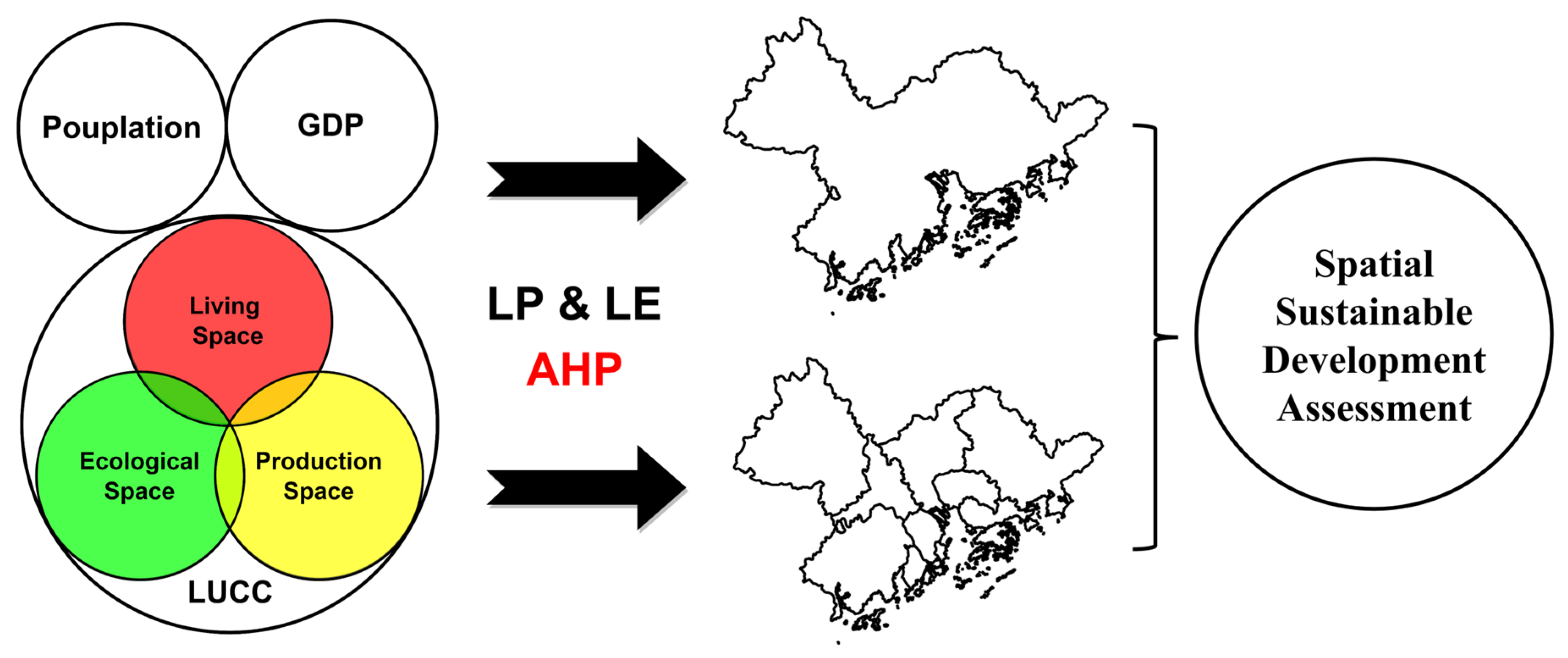

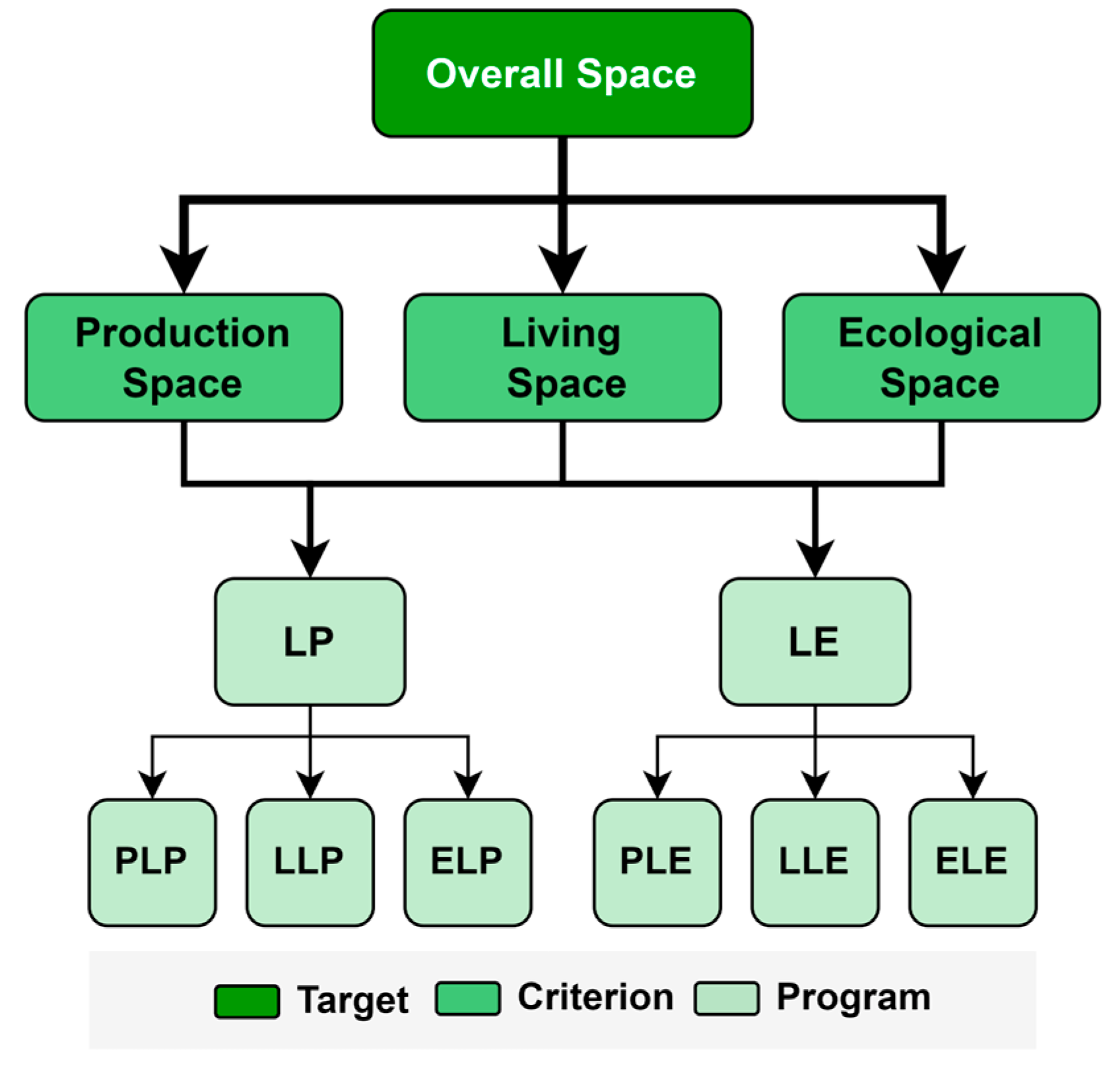
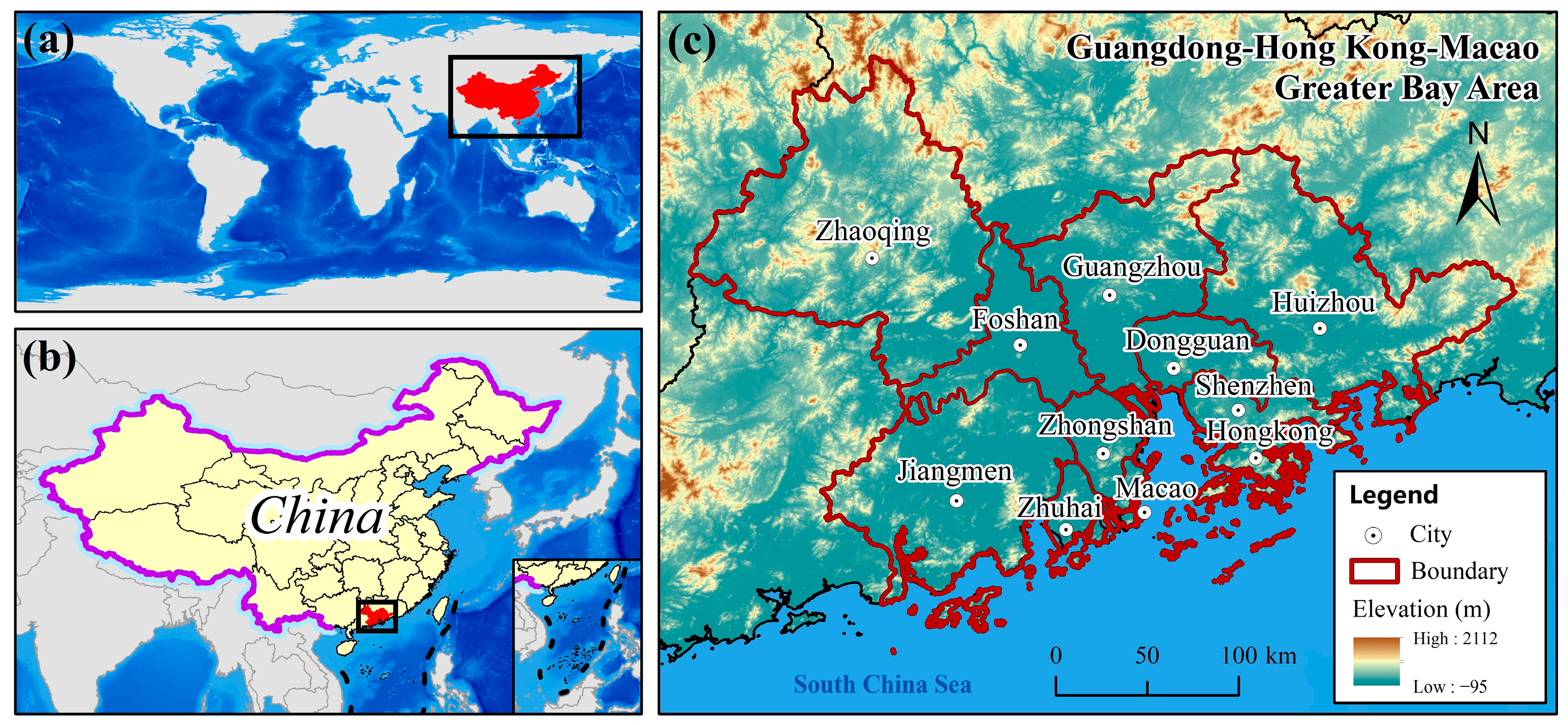

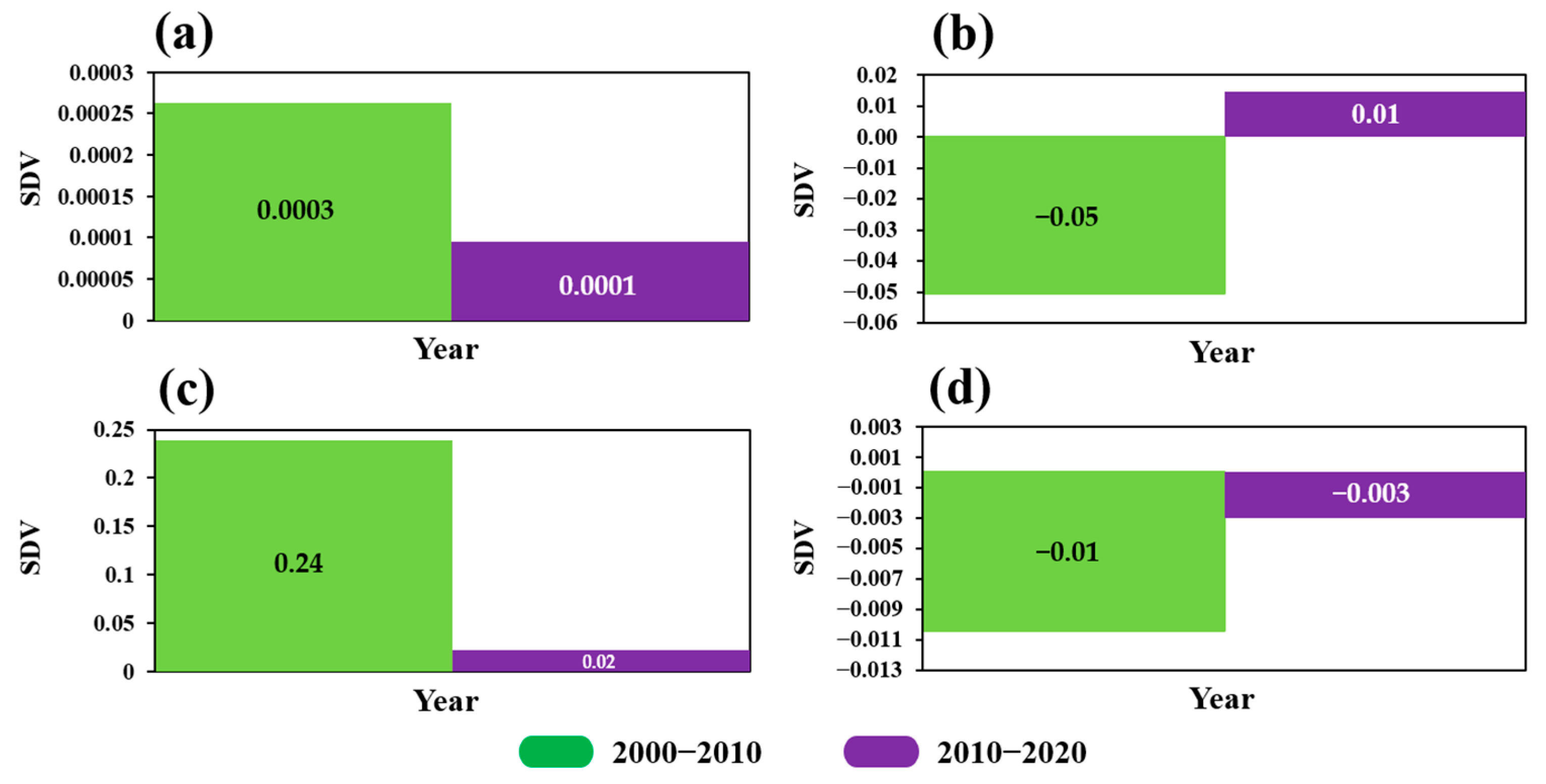
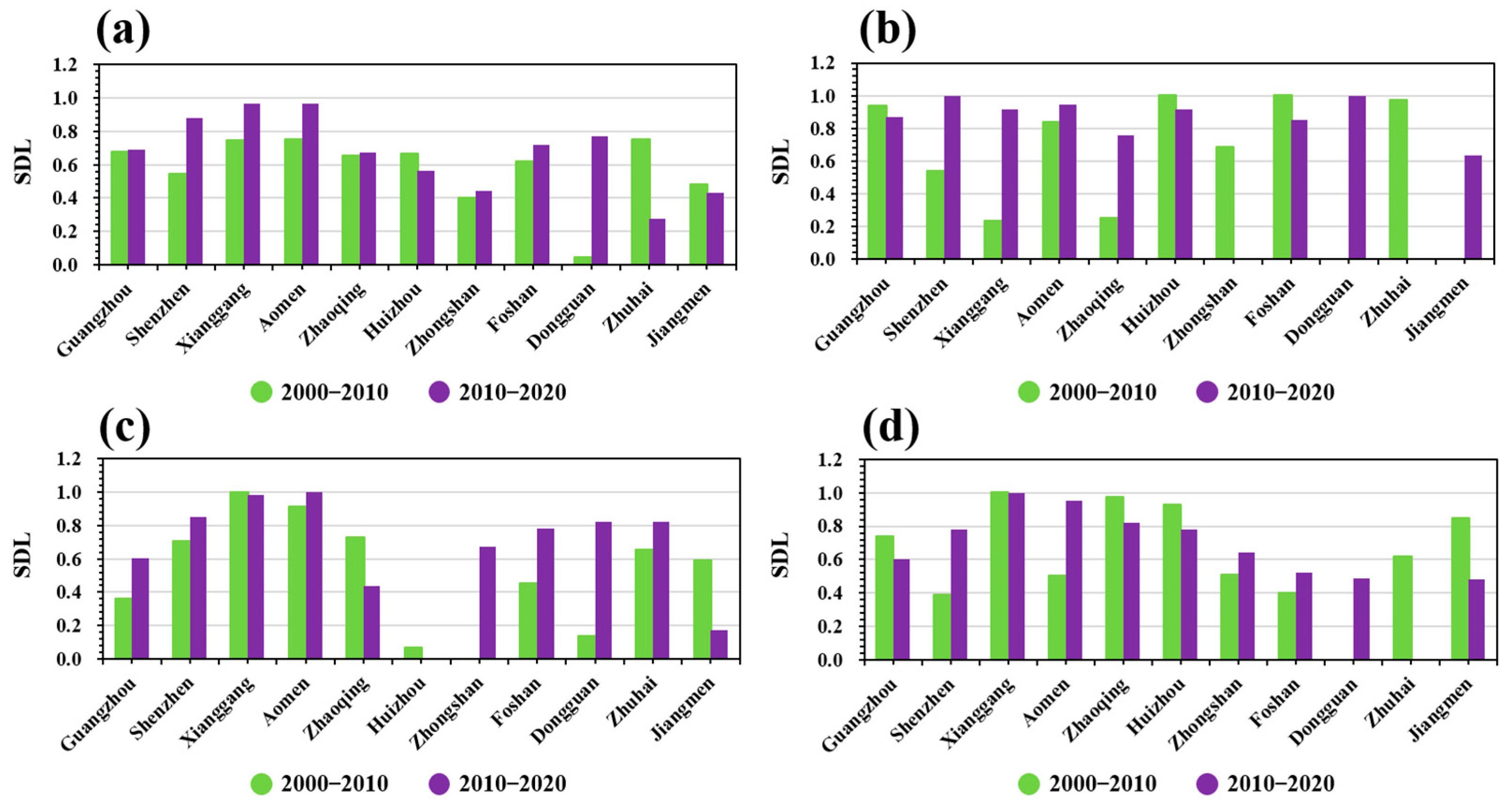


| First Class | Second Class | Features | Weights | ||
|---|---|---|---|---|---|
| Name | Name | Production | Living | Ecological | |
| 1. Arable land | 11. Paddy field | Guarantee food supply and safety, purifies the environment, and has a landscape ecology function. | 0.5 | 0 | 0.5 |
| 12. Dry land | 0.5 | 0 | 0.5 | ||
| 2. Woodland | 21. Forest land | Ecological functions such as windbreak, sand fixation, and oxygen supply are the main functions; supplemented by the production of fruit and edible oil. | 0.25 | 0 | 0.75 |
| 22. Shrub wood | Mainly reduce surface temperature and water evaporation, weakens sandstorm; supplemented by producing feed and fuel to attain economic benefits. | 0.25 | 0 | 0.75 | |
| 23. Open woodland | A land use type with a single ecological function, slow growth, and difficulty in natural regeneration. | 0 | 0 | 1 | |
| 24. Other woodland | Mainly in orchards, mulberry orchards, tea gardens, and thermal forest gardens, with equal emphasis on ecological functions and production functions | 0.5 | 0 | 0.5 | |
| 3. Grassland | 31. High-coverage grass | Mainly focus on protecting biodiversity, maintaining water and soil, and maintaining ecological balance; supplemented by developing animal husbandry. | 0.25 | 0 | 0.75 |
| 32. Medium-coverage grass | 0.25 | 0 | 0.75 | ||
| 33. Low-coverage grass | 0.25 | 0 | 0.75 | ||
| 4. Waters | 41. Canals | Mainly conserving water resources and degrading pollutants; providing domestic water; supplemented by leisure and entertainment; it also has certain shipping and fishery production functions. | 0.14 | 0.28 | 0.56 |
| 42. Lake | Mainly adjustment of the temperature and local climate; supplemented by human recreation and tourism; it can also support freshwater aquaculture fishery production activities in certain areas. | 0.14 | 0.28 | 0.56 | |
| 43. Reservoir pond | 0.14 | 0.28 | 0.56 | ||
| 44. Permanent glacier snow | Mainly for climate regulation; supplemented by hydropower. | 0.25 | 0 | 0.75 | |
| 45. Tidal flat | Biodiversity protection and coastal erosion control are the main functions; tidal flat farming is supplementary function; it also has a certain recreational tourism function. | 0.28 | 0.14 | 0.56 | |
| 46. Bottomland | 0.28 | 0.14 | 0.56 | ||
| 5. Urban and rural, industrial and mining residential land | 51. Urban land | Mainly serves a residential function for human life; the green landscape in the residential area has certain ecological benefits. | 0 | 0.75 | 0.25 |
| 52. Rural settlement | 0 | 0.75 | 0.25 | ||
| 53. Other construction land | It is mainly used for production functions such as oil fields, salt fields, and quarries; supplemented by dynamic living functions such as airports and transportation land. | 0.75 | 0.25 | 0 | |
| 6. unused land | 61. Sand | There is no place for human production and living, it mainly exerts its own single ecological function, and the ecological value is low. | 0 | 0 | 1 |
| 62. Gobi | 0 | 0 | 1 | ||
| 63. Saline-alkali land | 0 | 0 | 1 | ||
| 64. Wetlands | 0 | 0 | 1 | ||
| 65. Bare land | 0 | 0 | 1 | ||
| 66. Bare rock | 0 | 0 | 1 | ||
| 67. Other unused land | 0 | 0 | 1 | ||
| 99. Ocean | Nutrient circulation, water regulation, and other ecological functions are the main functions; marine aquaculture, shipping, and oil and gas industry are supplemented functions; there is also a certain tourism and leisure functions. | 0.28 | 0.14 | 0.56 | |
| Factor i Compared to Factor j | Judgment Scale |
|---|---|
| Equally important | 1 |
| Slightly important | 3 |
| More important | 5 |
| Strongly important | 7 |
| Extremely important | 9 |
| The median value of two adjacent judgments | 2, 4, 6, 8 |
| N | 1 | 2 | 3 | 4 | 5 | 6 | 7 | 8 | 9 |
|---|---|---|---|---|---|---|---|---|---|
| RI | 0 | 0 | 0.58 | 0.90 | 1.12 | 1.24 | 1.32 | 1.41 | 1.45 |
| Type of Space | Weights | Indicators | Weights |
|---|---|---|---|
| Production Space | 0.62 | PLP | 0.63 |
| PLE | 0.57 | ||
| Living Space | 0.27 | LLP | 0.26 |
| LLE | 0.29 | ||
| Ecological Space | 0.12 | ELP | 0.11 |
| ELE | 0.14 |
| CI | RI | CR | Result | |
|---|---|---|---|---|
| 3.04 | 0.019 | 0.52 | 0.037 < 0.1 | Pass |
| CI | RI | CR | Result | |
|---|---|---|---|---|
| 3 | 0 | 0.52 | 0 < 0.1 | Pass |
| Data | Sources | Time |
|---|---|---|
| LUCC (30 M × 30 M) | http://www.resdc.cn (accessed on 1 July 2021) | 2000/2010/2020 |
| Population | Guangdong Statistical Yearbook; HKSAR Government, Census and Statistics Department; Government of the Macao Special Administrative Region-Bureau of Statistics and Census | 2000/2010/2020 |
| GDP | Guangdong Statistical yearbook; Statistics page for Guangdong-Hong Kong-Macao Greater Bay Area | 2000/2010/2019 |
| Spaces | Production Space | Living Space | Ecological Space | |
|---|---|---|---|---|
| Cities | ||||
| Zhaoqing | — | ★★★ | ★★ | |
| Huizhou | ★ | ★★★ | ★★ | |
| Jiangmen | — | ★★★ | ★★ | |
| Guangzhou | ★★ | — | ★★★ | |
| Hongkong | — | ★★★ | — | |
| Zhuhai | ★★★ | — | ★★★ | |
| Zhongshan | ★★★ | — | — | |
| Foshan | ★★★ | — | — | |
Publisher’s Note: MDPI stays neutral with regard to jurisdictional claims in published maps and institutional affiliations. |
© 2022 by the authors. Licensee MDPI, Basel, Switzerland. This article is an open access article distributed under the terms and conditions of the Creative Commons Attribution (CC BY) license (https://creativecommons.org/licenses/by/4.0/).
Share and Cite
Gao, K.; Yang, X.; Wang, Z.; Zhang, H.; Huang, C.; Zeng, X. Spatial Sustainable Development Assessment Using Fusing Multisource Data from the Perspective of Production-Living-Ecological Space Division: A Case of Greater Bay Area, China. Remote Sens. 2022, 14, 2772. https://doi.org/10.3390/rs14122772
Gao K, Yang X, Wang Z, Zhang H, Huang C, Zeng X. Spatial Sustainable Development Assessment Using Fusing Multisource Data from the Perspective of Production-Living-Ecological Space Division: A Case of Greater Bay Area, China. Remote Sensing. 2022; 14(12):2772. https://doi.org/10.3390/rs14122772
Chicago/Turabian StyleGao, Ku, Xiaomei Yang, Zhihua Wang, Huifang Zhang, Chong Huang, and Xiaowei Zeng. 2022. "Spatial Sustainable Development Assessment Using Fusing Multisource Data from the Perspective of Production-Living-Ecological Space Division: A Case of Greater Bay Area, China" Remote Sensing 14, no. 12: 2772. https://doi.org/10.3390/rs14122772
APA StyleGao, K., Yang, X., Wang, Z., Zhang, H., Huang, C., & Zeng, X. (2022). Spatial Sustainable Development Assessment Using Fusing Multisource Data from the Perspective of Production-Living-Ecological Space Division: A Case of Greater Bay Area, China. Remote Sensing, 14(12), 2772. https://doi.org/10.3390/rs14122772









